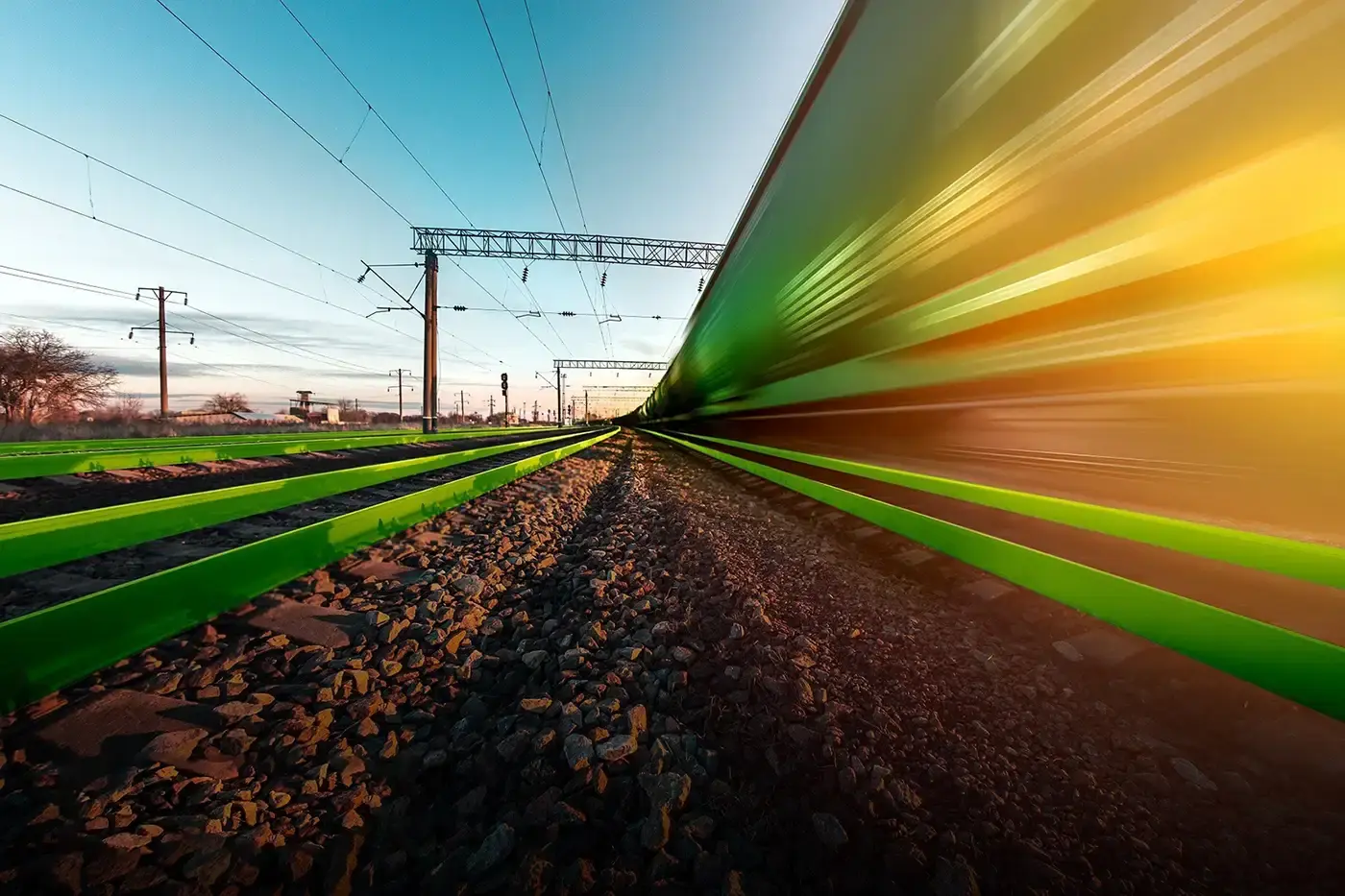Discover the benefits
Cargo can be transported by road, water, air, or rail Depending on the wishes of the end customer, it is often examined which type of modality fits best. However, what are the advantages of rail transport?
Rail freight is safe, efficient, stable and punctual – and has a low environmental impact. In addition, it is much less prone to delays on increasingly busy road networks. Many destinations in Europe can be reached by train within a day. Due to the short travel times, rail transport is ideal for quickly moving freight over long distances and provides an efficient solution for transporting large volumes swiftly. Read below for all the benefits of rail freight transport:
Reliable and fast
Rail freight operators achieve a reliability rate of 97% for top services provided to retailers, and generally, rail freight can match or even exceed the reliability of road transport. In the future, trains will become longer, allowing for more volume to be transported. Additionally, with the implementation of ERTMS, trains can run closer together, increasing network capacity.

Cost-efficient and economies of scale
As many companies in the rail freight sector continue to invest in new equipment, costs are increasingly reduced. For example, the average tonnage per train has increased by 80% over the past ten years. Particularly for medium distances, rail transport is a competitive mode compared to road transport. This is due to the economies of scale of the train. One train is equivalent to about 90 TEU or 50 trucks. This applies not only to traction but also to staffing: 1 driver versus 50 drivers. Additionally, in many European countries, a higher tonnage is allowed on the road in the final transport leg if the container was transported by rail, i.e., 44 tons versus the usual 40 tons.

Better for the Environment
Rail freight transport reduces CO2 emissions by up to 76% compared to road transport. This helps limit the impact of traffic emissions on global warming. For comparison, transporting 1 ton of goods by rail results in 80% less CO2 emissions than by road. Rail can also handle large volumes. One freight train carries as much as an average of 56 trucks combined.
Rail transport is also beneficial for society as it reduces harmful emissions and congestion, provides high-quality jobs, and contributes to the growth and prosperity of many regions in the Netherlands and beyond.

Improved air quality
Rail produces up to 10 times fewer small particulates than road transport and up to 15 times less nitrogen oxide for the same transported mass. This benefits the health of society, especially the younger generation.

Less traffic and safer
The volume that one train can carry is equivalent to an average of 56 trucks, resulting in 1.6 billion fewer truck kilometers on the road per year. Additionally, rail is the safest mode of transport, making it a significant societal benefit.
Supporting regional economic growth
Rail freight transport is vital for the economic prosperity of ports, power plants, manufacturing centers, and retail centers in both the Netherlands and Europe. Rail freight connects the Dutch economy with Europe. From our ports, there are good rail connections to European economic centers, ensuring goods can be transported from A to B as efficiently, safely, and sustainably as possible. Additionally, the rail sector provides high-quality jobs. Learn more about this on The Future is Ours (link).
Eco-friendly
Thanks to innovation within the sector, such as electrically powered locomotives, rail freight transport is a more sustainable form of transport than more traditional forms like air and sea cargo. Additionally, because of the large volumes that one train can transport, the total CO2 emissions per container or wagon are much lower than with road transport. Of course, road transport will remain complementary to rail for the first or last mile in many cases, but for fixed routes or distant destinations, rail freight transport is usually the most environmentally friendly solution.
Sustainability performance of rail transport
Rail freight transport is the most sustainable transport modality. This is evidenced by research from the Central Commission for the Navigation of the Rhine (October 2017). This was also previously shown by the Key Planning Decision (KPD) of the Betuweroute (1992) and the report “Rail Brings the Netherlands Forward” by Boer & Croon in 2014. Since the Paris Climate Agreement (COP 21), this theme has been increasingly emphasized by shippers (producers), including sustainable transport solutions.
Aside from energy consumption and emissions, several factors contribute to the sustainability performance of rail transport, such as: load factor during loaded trips, proportion of productive kilometers, detour percentage, pre- and post-transport (by truck), emissions at terminals, and the use of electric or diesel locomotives.
STREAM Freight transport 2016
The report provides representative average emission figures per mode of transport, suitable for general (policy) analyses where averages suffice. Additionally, the report provides detailed metrics with which emissions can be calculated in specific situations by users who have information about the type of vehicle or vessel used and its operation (type of goods, type of route):
Safe
Transport by rail is one of the safest ways to transport. The chance of accidents is very small, it is less prone to theft, and goods remain better intact compared to other transport modalities. Carriers, shippers, governments, safety regions, and ProRail closely share information about their trains and cargo, and the current situation on the rail network. This makes rail transport increasingly reliable. Finally, you can transport single containers on a train or book an entire block train.
ATB System
The Dutch rail system is one of the safest in the world. This is partly due to the installed ATC (automatic train control) safety system. The ATC system intervenes if a driver ignores a signal. This automatically brings the train to a stop. However, the system is only active from a speed of 40 km/h. Therefore, a driver can still run a red signal without the ATC system intervening. Due to these drawbacks, the ATC New Generation was developed in the 1990s, which does not have these drawbacks.
ERTMS
In the 1990s, the development of a European standard for the rail safety system, the European Rail Traffic Management System (ERTMS), began. This method allows for precise detection of the train’s position, distance, and speed. The system is installed in the tracks and detects all movements of the equipment. In the Netherlands, it has been implemented on the Betuweroute and High-Speed Line South.
The main goal of ERTMS is to promote interoperability, so that drivers can safely and optimally drive their trains across borders with the same locomotive. An additional advantage is that capacity on the existing network increases, as trains can run closer together.
Hazardous materials
Special attention is given to the transport of hazardous materials in the rail sector. This special care translates into a very low number of accidents involving hazardous materials. Historically, rail transport has an advantage over road transport in terms of safety reputation. Nevertheless, rail freight operators continuously work to further improve safety levels. They aim for a joint approach involving infrastructure managers, carriers, and the government to enhance safety on the rail network. One result is the Safety Agenda developed by KNV Spoorgoederen and ProRail.
Want to read more about hazardous materials transport? Visit Rijksoverheid.nl
Less prone to theft
Compared to road transport, rail transport is much less prone to theft. This is because criminals have less access to a train to remove products from a container. Theft of trucks parked at rest areas is much easier, as access is more straightforward.
Reliable
‘Less affected by congestion’
Punctuality
In recent years, carriers have worked hard to improve punctuality. This makes rail a reliable mode to use. Thanks to the use of smart technological solutions and, for example, the ERTMS system, reliability will continue to improve.
Communication
Besides punctuality, communication to customers about arrival times and possible delays is very good in rail freight transport. Significant improvements have been made, with customers being promptly informed about arrival times and delays being immediately communicated.
Little to no congestion
Rail freight operators make timely contact with the train service controllers of the rail infrastructure managers ProRail (mixed network) when they want to use the track. This allows rail infrastructure managers to set up a strict timetable and ensure that trains run as closely as possible according to this schedule. This results in relatively little congestion on the rail network, benefiting the reliability of rail as a mode of transport.
Stable pricing
The pricing of rail freight transport is remarkably stable compared to other modalities. This is partly because agreements are made for longer periods and the absence of various surcharges.

